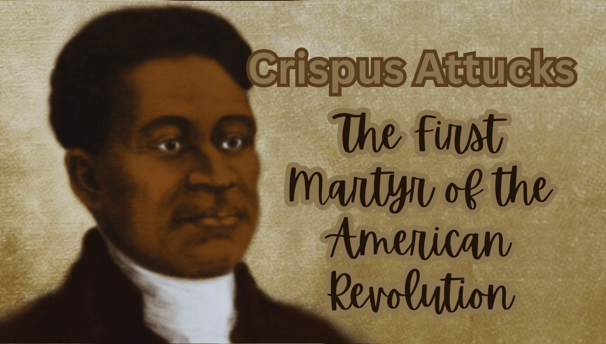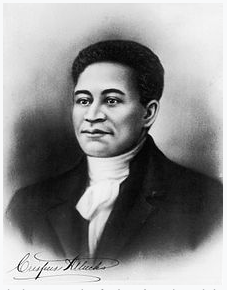Crispus Attucks: The First Martyr of the American Revolution
Crispus Attucks (c. 1723 – March 5, 1770) holds a significant place in American history as the first person killed in the Boston Massacre, an event that galvanized colonial opposition to British rule. Attucks, a man of mixed African and Native American heritage, is traditionally regarded as the first casualty of the American Revolutionary War. His life and death continue to be a symbol of resistance and sacrifice for liberty.
Casey Adams
2/6/20254 min read


Early Life: Origins and Identity
The details of Crispus Attucks' early life remain unclear, though historians agree he was of Wampanoag and African descent.
Born around 1723 in Framingham, Massachusetts, Attucks likely grew up in a colonial society rife with racial and social inequalities.
Some sources suggest he was born a free man, while others argue he was an escaped slave.
The latter theory stems from a 1750 advertisement in the Boston Gazette describing Crispus, a runaway enslaved man with characteristics matching Attucks' description.
However, no conclusive evidence links this advertisement directly to Attucks.
Despite his uncertain legal status, Attucks spent much of his adult life as a sailor, whaler, and dockworker, traveling along the Atlantic coast.
His transient lifestyle reflected the limited opportunities available to people of African and Indigenous heritage in colonial America.
Context: Tensions in Boston
By the late 1760s, tensions between British authorities and the American colonists had reached a boiling point.
The Townshend Acts of 1767 had imposed taxes on essential goods, fueling widespread resentment. British troops were sent to Boston in 1768 to maintain order, but their presence only deepened the animosity.
The city became a powder keg of unrest, with frequent clashes between Bostonians and British soldiers.
These tensions came to a head in early 1770 when Christopher Seider, an 11-year-old boy, was killed by a British customs official during a protest.
His death further inflamed anti-British sentiment, setting the stage for the events of March 5, 1770.
The Boston Massacre:
Crispus Attucks' Role
On the evening of March 5, 1770, a confrontation erupted between a group of Boston residents and British soldiers stationed outside the Custom House on King Street.
Crispus Attucks, who had been in Boston as part of his maritime work, became a central figure in the unfolding events.
Eyewitness accounts describe Attucks as standing at the forefront of the crowd, actively confronting the soldiers. Some reports suggest he brandished a stick or club, a symbol of his defiance.
The situation escalated as the crowd hurled insults, snowballs, and debris at the soldiers.
Amid the chaos, the soldiers opened fire, killing Crispus Attucks instantly along with four others.
Eight others were injured, two of whom later succumbed to their wounds.
Attucks' prominent position in the crowd and his immediate death made him the first casualty of the Boston Massacre and, by extension, the first American to die in the struggle for independence.
Aftermath: Legacy and Memory
Funeral and Public Mourning
The deaths of Attucks and the other victims sparked outrage throughout the colonies. Their funeral procession on March 8, 1770, was attended by thousands, a rare honor at the time.
The event became a rallying point for the Patriot cause, highlighting the brutality of British rule.
Trial of the British Soldiers
The British soldiers involved in the massacre were arrested and tried for murder.
In a trial that captured the attention of the colonies, the soldiers were defended by future president John Adams, who argued they acted in self-defense.
Six soldiers were acquitted, while two were convicted of manslaughter and given reduced sentences.
Adams referred to the crowd as a "motley rabble," a term that underscores the diverse backgrounds of those who resisted British authority, including sailors, laborers, and freedmen like Crispus Attucks.
Symbol of Resistance
In the years following the massacre, Attucks became a powerful symbol of resistance and the fight for liberty.
His mixed African and Native American heritage highlighted the diverse contributions to the Patriot cause, and his death underscored the stakes of the struggle for independence.
During the abolitionist movement of the 19th century, Attucks was celebrated as a hero who embodied the ideals of freedom and equality.
His name and legacy were invoked by civil rights leaders as a reminder of the sacrifices made by African Americans in the pursuit of justice.
Debates About Attucks’ Identity
Historians have long debated aspects of Attucks' identity, including whether he was a free man or an escaped slave. The lack of definitive records has left his early life shrouded in mystery.
Additionally, contemporary accounts of the Boston Massacre did not explicitly describe Attucks as Black or African, referring to him instead as a "mulatto" or a man of mixed ethnicity.
These descriptions reflect the complexities of race in colonial America, where societal perceptions of identity often differed from modern understandings.
Modern Recognition
Today, Crispus Attucks is celebrated as a national hero and a symbol of sacrifice in the name of freedom.
His legacy is honored in various ways:
Crispus Attucks Day: Some communities observe a day in his honor, reflecting on his role in American history.
Monuments: The Boston Massacre Monument in Boston Common prominently features Attucks among the fallen.
Schools and Organizations: Numerous schools and community centers across the United States bear his name, keeping his memory alive.
Conclusion
Crispus Attucks’ death on March 5, 1770, marked a pivotal moment in American history.
As the first casualty of the Boston Massacre, he became a symbol of resistance and a rallying point for the Patriot cause.
His story is a reminder of the diverse individuals who shaped the struggle for American independence and the enduring quest for liberty and justice.
Despite the uncertainties surrounding his life, Crispus Attucks' legacy as a martyr for freedom endures, inspiring generations to remember the sacrifices that laid the foundation for the United States.
Crispus Attucks



